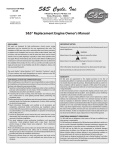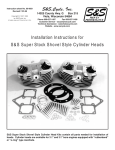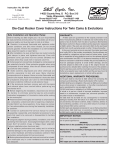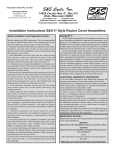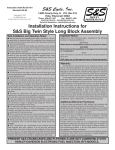Download S&S Cycle Motorcycle Accessories Owner`s manual
Transcript
1 Owner's Manual No. 51-1002 2-8-01 Copyright ©, 2001 by S&S Cycle, Inc. All rights reserved. Printed in the U.S.A. S&S Cycle, Inc. 14025 County Hwy. G P.O. Box 215 Viola, Wisconsin 54664 Phone 608-627-1497 Fax 608-627-1488 Customer Service Email: [email protected] Technical Service Email: [email protected] S&S TÜV Long Block Owner's Manual Congratulations on purchasing an S&S engine! Your new engine is designed and manufactured with the same care and attention to detail as those used to set speed records and win races around the world. This engine conforms to all applicable regulations effective on the date of manufacture. This manual has been prepared to acquaint you with the operation, care, and maintenance of your engine, to notify you of important safety information, and to provide authorized service personnel with necessary emissions control specifications. Other S&S publications discuss repairs and/or changes to the engine configuration. The motorcycle manufacturer’s manuals should be consulted for information related to other parts of the motorcycle. OWNER INFORMATION ENGINE AND VEHICLE INFORMATION Name: ___________________________________________ Engine Identification No.: ____________________________________ Street: ___________________________________________ Displacement: _____________________________________________ City: _____________________________________________ TÜV Certification No. - EMC: __________ 350-576-99-FBTK_________ State: ____________________ Zip Code: ______________ TÜV Certification No. - Engine Description: ________________________ Telephone: ________________________________________ TÜV Certification No. - Exhaust: ________________________________ Notes _____________________________________________ TÜV Certification No. - Sound: _________________________________ ___________________________________________________ Ignition System: ____________________________________________ ___________________________________________________ Vehicle Identification No.: ____________________________________ IMPORTANT NOTICE Statements in this Owner’s Manual preceded by the following words are of special significance. WARNING Means there is the possibility of injury to yourself or others. CAUTION Means there is the possibility of damage to the engine or motorcycle. NOTE Other information of particular importance has been placed in italic type. 2 TABLE OF CONTENTS ENGINE IDENTIFICATION NUMBER ............................... 3 REGULAR SERVICE INTERVALS ................................. 5 CONTROLS AND GAUGES .............................................. 3 ENGINE OIL ................................................................... 6 ENRICHMENT DEVICE .................................................. 3 CHECKING, ADDING, & CHANGING ENGINE OIL ....... 6 PETCOCK ...................................................................... 3 HYDRAULIC LIFTER OIL FILTER SCREEN .................. 6 OPERATION ..................................................................... 3 GAS TANK FUEL STRAINER AND IN-LINE FILTER ..... 6 ENGINE SPEED AND LOAD .......................................... 3 CARBURETOR .............................................................. 6 IDLE SPEED .................................................................. 3 Idle Speed Adjustment .................................................. 6 OIL PRESSURE ............................................................. 3 AIR CLEANER ELEMENT .............................................. 6 ALTITUDE ...................................................................... 3 HYDRAULIC LIFTERS ................................................... 7 BREAK-IN ...................................................................... 3 SPARK PLUGS .............................................................. 7 PRE-RIDING CHECKLIST .............................................. 4 Spark Plug Removal ..................................................... 7 STARTING AND WARM-UP ........................................... 4 Spark Plug Inspection ................................................... 7 General ........................................................................ 4 Spark Plug Installation .................................................. 7 Cool Engine ................................................................. 4 IGNITION TIMING .......................................................... 7 Warm or Hot Engine ..................................................... 4 Ignition Timing Check ................................................... 7 JUMP STARTING ........................................................... 4 Ignition Timing Adjustment ............................................ 7 GEAR CHANGE SPEEDS .............................................. 4 STORAGE ...................................................................... 7 MAINTENANCE ................................................................ 5 SPECIFICATIONS 88" & 89" ............................................ 8 PERIODIC ...................................................................... 5 SPECIFICATIONS 93" & 96" ............................................ 9 BREAK-IN ...................................................................... 5 SPECIFICATIONS 100" & 107" ....................................... 10 Maintenance at 50 Miles ............................................... 5 SPECIFICATIONS 113" ................................................... 11 Maintenance at 500 Miles ............................................. 5 3 ENGINE IDENTIFICATION NUMBER OPERATION The Engine Identification Number (EIN) is stamped on the left side of the crankcase below the front cylinder deck, and on the right side immediately forward of the front tappet guide. It consists of a seven-character code (see example below). The first and last characters are stars (*). The second character is a letter that designates the code for the model year of the engine. The four characters that follow are the crankcase serial/sequence number for that year. ENGINE SPEED AND LOAD CAUTION - Do not run engine above 2,500 RPM with clutch disengaged or transmission in neutral. Exceeding 6,500 RPM under any circumstances may damage the engine. *W1234* * - Leading Star W - Year Code 1996 1997 1998 1999 2000 2001 W X Y Z A B 1234 - Crankcase Sequence Number for that Year. * - Trailing Star An engine run long distances at high speed or under heavy load may overheat. Oil and spark plugs should be inspected more frequently when the engine is subjected to extreme temperatures. IDLE SPEED CAUTION - Do not idle engine more than five minutes with motorcycle standing still. Overheating may result. Normal warm idle speed is 900 RPM. When the enrichment device lever is pulled up with a cold engine, the idle will be higher. OIL PRESSURE Engine oil pressure varies from 5 psi (.34 bar) at idle to 12-15 psi (.83-1bar) at 50 mph (80 kph) when the engine is at normal operating temperature. CONTROLS AND GAUGES The starter, key switch, engine-stop switch, throttle control grip, tachometer (if available), speedometer, oil pressure gauge, voltmeter, and fuel gauge are discussed in detail in the motorcycle owner’s manual. ENRICHMENT DEVICE The carburetor uses a mixture enrichment device instead of a choke, but it is operated in a similar manner. During starting and operation before the engine is warmed up, the lever located on the upper side of the air cleaner is pulled up. When the engine is sufficiently warm, as described in the OPERATION section, the enrichment device lever is pushed down. PETCOCK The petcock is located under the fuel tank as described in the motorcycle owner’s manual. On some motorcycles, the petcock operates automatically. On others, manual operation is required. WARNING/CAUTION - Motorcycles with manualoperated petcock: petcock should always be closed when engine is not running to prevent accidental overflow of gasoline and possible fire hazard or damage to engine. Further information about the petcock may be found in the motorcycle owner’s manual. ALTITUDE The factory engine calibration was performed at an altitude of 800 feet (250 meters) (Viola, Wisconsin USA). The engine should operate correctly between sea level and 2,000 feet (600 meters) without further adjustment. BREAK-IN During the first 500 miles (800 kilometers) of operation, critical parts are “breaking-in” against each other. For this reason: 1. Avoid excessive heat build-up. Do not allow engine to idle for long periods of time. 2. Keep the outside of the engine clean. 3. Do not subject engine to unusual stress or load as with sidecar or trailer. 4. Avoid hard acceleration until the engine is warmed up. Do not lug the engine. Vary the engine speed; avoid maintaining a steady speed for long distances. 5. First 50 Miles (80 Kilometers) - Without lugging the motor, do not exceed 50 mph (80 kph). Keep the engine speed below 2,500 RPM. Change the oil and filter at 50 miles (80 kiliometers). 6. Up to 500 Miles ( 800 Kilometers) - Do not exceed 65 mph (105 kph). Keep the engine speed below 3,000 RPM. Change the oil and filter at 500 miles (800 kilometers). 7. Up to 2,500 Miles (4000 Kilometers) - Keep the engine speed below 3,500 RPM. 4 Road Speed At 2,000 & 3,000 RPM In Each Gear Based On Stock Late-Model Harley-Davidson FL and FX Overall Gear Ratios and Rear Tire Size Gear Road Speed at 2,000 RPM 1st 15 mph (24 kph) 22 mph (35 kph) nd 22 mph (35 kph) 32 mph (52 kph) 3rd 30 mph (48 kph) 44 mph (71 kph) th 4 39 mph (63 kph) 58 mph (93 kph) 5th 47 mph (75 kph) 71 mph (114 kph) 2 Road Speed at 3,000 RPM For motorcycles not equipped with tachometers, the following table may be used as a guide for estimating the engine RPM in each gear based on the road speed. b. 70°F (21°C) or Warmer - Push enrichment lever completely in after 10 to 30 seconds of operation. PRE-RIDING CHECKLIST Before riding or with each tank of gas, confirm that your motorcycle is in good operating condition. The motorcycle owner’s manual has specific information regarding this subject. Warm or Hot Engine: 1. Open petcock if it is manual type. 2. Pull enrichment lever to fully raised position. 3. Turn Key to IGNITION. 4. Turn Engine-Stop Switch to RUN. 5. Press Start Switch. 6. After engine starts, immediately push enrichment lever all the way in. To insure safe, reliable engine operation: 1. Check oil level in oil tank. 2. Check for oil and fuel leaks. STARTING AND WARM-UP General: 1. Before starting engine, shift transmission into neutral. 2. Never allow engine to exceed 2,500 RPM immediately after cold start. Engine should run slowly for 15 to 30 seconds. This allows engine to warm up, and oil to reach all surfaces requiring lubrication. 3. Idling with enrichment device lever in full-out position for longer than 30 seconds is not recommended. Lever may be set in intermediate position if engine will not run smoothly with it all the way in. 4. Use oil of viscosity recommended for expected ambient temperature range and type of operation. Cool Engine: 1. Open petcock if it is manual type. 2. Pull enrichment device lever to raised position. 3. Twist throttle one or two times. 4. Close throttle. 5. Turn Key to IGNITION. 6. Turn Engine-Stop Switch to RUN. 7. Press Start Switch. 8. After engine starts, adjust enrichment lever depending on ambient temperature: a. Below 70°F (21°C) - Push enrichment lever in as engine warms. If idle becomes slow or rough, pull lever up slightly. Enrichment lever should be pushed in completely after not more than 60 seconds of operation. JUMP STARTING Jump start the motorcycle according to the motorcycle owner’s manual. CAUTION - To avoid damage to ignition system, start engine using a 12 volt booster battery only. Confirm that jumper cables are connected correctly before attempting to start engine. WARNING - Many motorcycle frames do not allow easy access to battery terminals without touching jumper cables to conductive surfaces which may cause sparks. Batteries often emit explosive gas which sparks may ignite. For this reason battery should be removed from motorcycle for recharging. GEAR CHANGE SPEEDS For normal riding, the recommended acceleration shift points to higher gears while accelerating are shown on the following page. Note, for best fuel economy, use the smaller numbers in each speed range. For normal riding, the recommended shifting procedure to lower gears while decelerating is: 1. Disengage clutch. 2. As motorcycle slows, shift into appropriate gear for beginning next mode of operation. 5 Recommended Acceleration Shift Points Gear Change Engine RPM Approximate Road Speed 1 1st to 2nd 1800 to 2400 13 to 17 mph (21 to 27 kph) rd 2 to 3 2000 to 2300 20 to 24 mph (32 to 39 kph) 3rd to 4th 1900 to 2300 28 to 34 mph (45 to 55 kph) 2100 to 2300 39 to 43 mph (63 to 89 kph) nd th th 4 to 5 1 Based on late model Harley-Davidson FL and FX overall gear ratios and rear tire size. 3. When slowing to a stop, the clutch should be disengaged when: a. The motorcycle speed drops below approximately 15 mph (24 kph). b. Engine roughness is evident. c. When the engine is lugging. The motorcycle should be shifted into neutral if it is going to be shut off or kept at an idle for more than a few seconds. MAINTENANCE To keep your new engine warranty in force, and to assure proper emissions system operation, regular inspections and servicing must be performed. PERIODIC The motorcycle should be checked frequently (for example, with each tank of gasoline) for fuel or oil leaks and oil level. After the engine is warm, the idle speed may occasionally require minor adjustment. The air cleaner should be inspected every few hundred miles. See the motorcycle owner’s manual for other recommended periodic maintenance. BREAK-IN At 50 Miles (80 Kilometers): 1. S&S recommends an engine oil and filter change. 2. Inspect for fuel and oil leaks. 3. Inspect air cleaner element and service as required. 4. Check tightness of exterior fasteners, except head bolts. Maintenance at 500 Miles (800 Kilometers): 1. Change engine oil and filter. 2. Inspect for fuel and oil leaks. 3. Inspect air cleaner element and service as required. 4. Check tightness of exterior fasteners, except head bolts. 5. Check operation of enrichment device and throttle controls. 6. Check engine idle speed. 7. Check tightness of engine mounts. REGULAR SERVICE INTERVALS Regular lubrication and maintenance will help keep your new S&S engine operating at peak performance. The following table presents a recommended service schedule for average operating conditions. Please refer to the Harley-Davidson Owner’s Manual for the required regular maintenance intervals. CAUTION - Motorcycles operated under adverse conditions (severe cold, heat, dusty or wet conditions, extended idling, pro-longed high speed or extreme load), perform the regular maintenance more frequently to ensure safe, reliable operation. Recommended Engine Oils Ambient Temperature Range Viscosity Grade Below 40°F (4°C) (Winter Only) SAE 10W40 40°F (4°C) to 100°F (38°C) SAE 15W50 or 20W50 50°F (10°C) to Above 100°F (38°C) SAE 25W60 60°F (16°C) to 100°F (38°C) SAE 50 80°F (27°C) to Above 100°F (38°C) SAE 60 Notes: • Use only API SG or SH rated oil. • S&S recommends regular oil changes every 1,000 miles (1600 kilometers) when using petroleum-based oil not specifically formulated for motorcycles. 6 S&S Recommended Regular Service Intervals Item Interval Engine Oil & Filter .......... Change at 50, 500, 2,500 miles (80, 800, 4,000 kilometers), every 2,500 miles (4,000 kilometers) thereafter.1 Air Cleaner Element ................. Inspect at 50 and 500 miles (80 and 800 kilometers), every 2,500 miles (4,000 kilometers) thereafter.2 Replace every 5,000 miles (8,000 kilometers). 2 Tappet Oil Screen ............................................................................................................... Inspect every 2,500 miles (4,000 kilometers). Petcock, Lines, & Fittings, Vacuum Lines ...... Inspect at 50 and 500 miles (80 and 800 kilometers), every 2,500 miles (4,000 kilometers) thereafter. Fuel Tank Filter Screen & In-Line Fuel Filter (If used) .................................................................... Every 5,000 miles (8,000 kilometers). Engine Idle Speed ....................................................................................................................................................... Adjust as required. Operation of Throttle & Enrichment Device Controls .. Inspect at 500 miles (800 kilometers) and every 2,500 miles (4,000 kilometers) thereafter. Spark Plugs .................. Inspect every 5,000 miles (8,000 kilometers). Replace every 10,000 miles (16,000 kilometers) or as needed. Ignition Timing .................................................................................................................... Inspect every 5,000 miles (8,000 kilometers). Engine Mounts ...................................... Inspect every 500 miles (800 kilometers) and every 5,000 miles (8,000 kilometers) thereafter. External Fasteners Except Engine Head Bolts .. Re-torque at 500 miles (800 kilometers) and every 5,000 miles (8,000 kilometers) thereafter. 1 2 S&S recommends that petroleum-based oil not specifically formulated for motorcycles should be changed every 1,000 miles (1,600 kilometers) after the break-in period. Replace more frequently if required or if engine is operated in a dusty environment. ENGINE OIL Engine oil is a major factor in the performance and service life of the engine. Use the proper grade of oil for the ambient temperature range anticipated before the next oil change as shown in the following table. Notes: Use only API SG or SH rated oil. S&S recommends regular oil changes every 1,000 miles (1,600 kilometers) when using petroleum-based oil not specifically formulated for motorcycles. CHECKING, ADDING & CHANGING ENGINE OIL See the motorcycle owner’s manual for information on how to check, add, and change the oil and filter. HYDRAULIC LIFTER OIL FILTER SCREEN The access screw for this screen is located on the right side of the crankcase beside the rear tappet block. Carefully remove the screw to expose the spring and filter screen located underneath. Remove the spring and filter screen from the crankcase. Clean or replace the screen. Reinstall the screen (open end down), spring, and screw. GAS TANK FUEL STRAINER AND IN-LINE FILTER Inspect and clean the gas tank fuel strainer according to the motorcycle owner’s manual. If an in-line filter is used (recommended) , it should be replaced or cleaned according to manufacturer’s specifications. CARBURETOR The carburetor has been specifically set up for emissions control. All jets are fixed at the factory. Idle Speed Adjustment 1. Operate motorcycle until engine is warmed up (typically 15 minutes). 2. The idle speed adjustment screw is located on top of the carburetor just under the throttle cable guide. Use a long, blade-type screwdriver to adjust the idle speed to 900 RPM. AIR CLEANER ELEMENT The special carbon air cleaner element supplied with TÜV Long Blocks was designed for superior flow and efficiency. The element reduces intake noise emissions, as well as prevents fuel vapors from entering the atmosphere while the engine is shut off. The element should be replaced every 5,000 miles (8,000 kilometers). It is designed to be run dry; i.e., without oil. Note - oiling filter will cause improper engine operation. If the poly-carbon element is torn, punctured or has excessive oil build-up, replace the element. Caution- A damaged, torn, or crushed element may release carbon into the engine resulting in severe engine damage. In the event of a damaged air cleaner element - replace element immediately. 7 1. 2. 3. 4. Remove air cleaner cover. Remove element. Reinstall new carbon element on air cleaner back plate. Reinstall air cleaner cover. HYDRAULIC LIFTERS Hydraulic lifters are self-adjusting. They automatically adjust length to compensate for engine expansion and valve train wear, keeping the valve train free of lash while the engine is running. When starting the engine, the valve train may be noisy until the lifters refill with oil. If the valve train remains noisy after twenty minutes of operation, this may be an indication that one or more of the lifters is not functioning properly. Then, if necessary, remove and clean the hydraulic lifter oil filter screen. Consult an S&S service agent if further service is required. SPARK PLUGS Spark Plug Removal: 1. Disconnect spark plug wires from spark plugs by pulling on the molded connector boots. It may help to twist or rock the boots back and forth slightly while pulling. 2. Unscrew spark plugs. Spark Plug Inspection: If either of the following conditions occurs, further service is required. 1. A spark plug with a black, glossy-wet coating indicates that oil is entering the combustion chamber. 2. A spark plug that is wet with gasoline or has sooty deposits indicates either a faulty ignition or a problem with carburetion. Spark Plug Installation: Spark plugs must be screwed in correctly to avoid crossthreading, and tightened adequately to ensure proper heat transfer. Do not over-tighten spark plugs. CAUTION - Threads may strip in the aluminum cylinder heads if over-tightened. Repair will not be covered under warranty. 1. Inspect spark plug threads and clean if necessary. 2. Start screwing spark plugs in by hand. They should screw in easily. 3. Torque spark plugs to 18 to 22 ft-lbs (24 to 30 N-m). IGNITION TIMING Timing advances electronically as the engine speed changes. Ignition Timing Check: 1. With engine not running, connect inductive timing light to front spark plug wire. 2. Loosen timing plug from left side of crankcase where two cylinders meet. WARNING - Oil mist will exit timing plug hole when engine is running. It is recommended that a transparent inspection plug (not provided) be installed prior to starting engine to prevent discomfort and possible injury to eyes. 3. Start engine and reach normal operating temperature. Using applicable manufacturer's Ignition Installation Instructions, set engine speed to recommended RPM. An inductive tachometer, attached to spark plug cable, may be helpful if the motorcycle is not equipped with a tachometer. Tachometers designed for "wasted spark" ignition systems may read half the actual engine speed. 4. Using dial-back timing light, set the amount of advance specified (28-32° bTDC full advance recommended). 5. Illuminate flywheel inside crankcase through transparent timing plug with timing light. The "T:F" mark stamped on the flywheel should be centered in the plug. 6. Remove transparent timing plug and reinstall metal one supplied with engine. Ignition Timing Adjustment - TO BE PERFORMED ONLY BY AN AUTHORIZED SERVICE AGENT - Use the Ignition Timing Check Procedure, except as follows: 1. Before starting engine, remove ignition sensor access plate from gear cover on right side of engine crankcase after removing two screws. 2. Slightly loosen two screws which hold sensor plate. 3. While engine is running, slightly rotate sensor plate. Clockwise rotation advances timing. 4. When timing is correct, tighten sensor plate screws and recheck timing. 5. Reinstall ignition sensor access plate and install the two screws. STORAGE If the motorcycle will be stored for several months, the carburetor float bowl should be drained to avoid a buildup of gum or varnish. The following procedure should be used: 1. Fully close the petcock. 2. Place small, open container below float bowl. 3. Unscrew drain plug to allow gasoline to drain into container. WARNING - Gasoline is extremely flammable and vapors can be toxic or explosive. Adequate ventilation must be provided and sparks or open flame avoided when working with gasoline. 4. Reinstall and tighten. 8 88 Cubic Inch Engine Specifications ENGINE IGNITION SYSTEM Number of Cylinders .............................................. 2 Timing ........................ 28° to 32° bTDC Full Advance Type .................................................. 4-Cycle, 45° V ................................................................................ Compression Ratio ............ Normal Altitude: 9.4 to 11 Spark Plug Type .......... Champion RN12YC or Equiv. Dry Weight .................................... ~ 165 lbs. (75 kg) Size .............................................. 14 mm, w/Washer Bore ............................................ 3-5/8 inch (92 mm) Gap ...................... 0.040 to 0.045 inch (1 to 1.1 mm)1 Stroke ....................................... 4-1/4 inch (108 mm) VALVE TRAIN Displacement (CI) ................................ 88 cubic inch Rocker-Arm Ratio ...................................... 1.625 to 1 Displacement (CC) ................................... 1,437.6 cc Intake Valve Diameter ........... 2.000 inches (50.8 mm) ................................................................................ Exhaust Valve Diameter ....... 1.605 inches (40.8 mm) ................................................................................ Peak Valve Lift ..................... 0.520 inches (13.2 mm)1 FUEL SYSTEM ....................................................... Intake ............................................. Open - 0° bTDC1 Carburetor...Super E (Butterfly, 1-7/8" (47.6 mm) Bore) .................................................... Close - 40° aBDC1 Fuel ........ Unleaded Gasoline: 91 Octane Minimum Exhaust ........................................ Open - 50° bBDC1 Warm Idle Speed ........................ 900 +/- 100 RPM ...................................................... Cloce - 2° aTDC1 ................................................................................ (Open/Close Timings @ 0.053 inch (1.346mm) Follower Lift) 1 These specifications may change to optimize engine performance and maintain low emissions. 89 Cubic Inch Engine Specifications ENGINE IGNITION SYSTEM Number of Cylinders .............................................. 2 Timing ....................... 28° to 32° bTDC Full Advance Type .................................................. 4-Cycle, 45° V ................................................................................ Compression Ratio .......... Normal Altitude: 10.1 to 11 Spark Plug Type ......... Champion RN12YC or Equiv. Dry Weight .................................... ~ 165 lbs. (75 kg) Size ............................................. 14 mm, w/Washer Bore ......................................... 3-1/2 inch (88.9 mm) Gap ..................... 0.040 to 0.045 inch (1 to 1.1 mm)1 Stroke .................................... 4-5/8 inch (117.5 mm) VALVE TRAIN Displacement (CI) ............................. 88.9 cubic inch Rocker-Arm Ratio ..................................... 1.625 to 1 Displacement (CC) ................................... 1,458.4 cc Intake Valve Diameter .......... 2.000 inches (50.8 mm) ................................................................................ Exhaust Valve Diameter ....... 1.605 inches (40.8 mm) ................................................................................ Peak Valve Lift .................... 0.520 inches (13.2 mm)1 FUEL SYSTEM ....................................................... Intake ............................................ Open - 0° bTDC1 Carburetor...Super E (Butterfly, 1-7/8" (47.6 mm) Bore) Close - 40° aBDC1 Fuel ........ Unleaded Gasoline: 91 Octane Minimum Exhaust ....................................... Open - 50° bBDC1 Warm Idle Speed ........................ 900 +/- 100 RPM ...................................................... Cloce - 2° aTDC1 (Open/Close Timings @ 0.053 inch (1.346mm) Follower Lift) 1 These specifications may change to optimize engine performance and maintain low emissions. 9 93 Cubic Inch Engine Specifications ENGINE IGNITION SYSTEM Number of Cylinders .............................................. 2 Timing ........................ 28° to 32° bTDC Full Advance Type .................................................. 4-Cycle, 45° V ................................................................................ Compression Ratio ............. Normal Altitude: 9.8 to 11 Spark Plug Type .......... Champion RN12YC or Equiv. Dry Weight ..................................... ~ 165 lbs. (75 kg) Size .............................................. 14 mm, w/Washer Bore ........................................... 3-5/8 inch (92 mm) Gap ...................... 0.040 to 0.045 inch (1 to 1.1 mm)1 Stroke ..................................... 4-1/2 inch (114.3 mm) VALVE TRAIN Displacement (CI) ............................. 92.8 cubic inch Rocker-Arm Ratio ...................................... 1.625 to 1 Displacement (CC) .................................. 1,522.1 cc Intake Valve Diameter ........... 2.000 inches (50.8 mm) ................................................................................ Exhaust Valve Diameter ....... 1.605 inches (40.8 mm) ................................................................................ Peak Valve Lift .................... 0.520 inches1 (13.2 mm)1 FUEL SYSTEM ....................................................... Intake ............................................. Open - 0° bTDC1 Carburetor...Super E (Butterfly, 1-7/8" (47.6 mm) Bore) Close - 40° aBDC1 Fuel ........ Unleaded Gasoline: 91 Octane Minimum Exhaust ........................................ Open - 50° bBDC1 Warm Idle Speed ........................ 900 +/- 100 RPM ...................................................... Cloce - 2° aTDC1 ................................................................................ 1 (Open/Close Timings @ 0.053 inch (1.346mm) Follower Lift) These specifications may change to optimize engine performance and maintain low emissions. 96 Cubic Inch Engine Specifications ENGINE IGNITION SYSTEM Number of Cylinders .............................................. 2 Timing ........................ 28° to 32° bTDC Full Advance Type .................................................. 4-Cycle, 45° V ................................................................................ 1 Compression Ratio .......... Normal Altitude: 10.1 to 1 Spark Plug Type .......... Champion RN12YC or Equiv. Dry Weight .................................... ~ 165 lbs. (75 kg) Size .............................................. 14 mm, w/Washer Bore ............................................ 3-5/8 inch (92 mm) Gap ...................... 0.040 to 0.045 inch (1 to 1.1 mm)1 Stroke ..................................... 4-5/8 inch(117.5 mm) VALVE TRAIN Displacement (CI) ............................. 95.5 cubic inch Rocker-Arm Ratio ...................................... 1.625 to 1 Displacement (CC) ................................... 1,564.4 cc Intake Valve Diameter ........... 2.000 inches (50.8 mm) ................................................................................ Exhaust Valve Diameter ....... 1.605 inches (40.8 mm) ................................................................................ Peak Valve Lift .................... 0.520 inches1 (13.2 mm)1 FUEL SYSTEM ....................................................... Intake ............................................. Open - 0° bTDC1 Carburetor Super E (Butterfly, 1-7/8" (47.6 mm) Bore) .................................................... Close - 40° aBDC1 Fuel ........Unleaded Gasoline: 91 Octane Minimum Exhaust ........................................ Open - 50° bBDC1 Warm Idle Speed ........................ 900 +/- 100 RPM ...................................................... Cloce - 2° aTDC1 ................................................................................ (Open/Close Timings @ 0.053 inch (1.346mm) Follower Lift) 1 These specifications may change to optimize engine performance and maintain low emissions. 10 100 Cubic Inch Engine Specifications ENGINE IGNITION SYSTEM Number of Cylinders ................................................ 2 Timing ........................ 28° to 32° bTDC Full Advance Type .................................................... 4-Cycle, 45° V ................................................................................ Compression Ratio .............. Normal Altitude: 9.0 to 11 Spark Plug Type .......... Champion RN12YC or Equiv. Dry Weight ...................................... ~ 165 lbs. (75 kg) Size .............................................. 14 mm, w/Washer Bore .............................................. 4 inch (101.6 mm) Gap ...................... 0.040 to 0.045 inch (1 to 1.1 mm)1 Stroke ............................................ 4 inch (101.6 mm) VALVE TRAIN Displacement (CI) ............................. 100.5 cubic inch Rocker-Arm Ratio ...................................... 1.625 to 1 Displacement (CC) .................................... 1,647.4 cc Intake Valve Diameter ........... 2.000 inches (50.8 mm) .................................................................................. Exhaust Valve Diameter ....... 1.605 inches (40.8 mm) .................................................................................. Peak Valve Lift ..................... 0.520 inches (13.2 mm)1 FUEL SYSTEM ......................................................... Intake ............................................. Open - 0° bTDC1 Carburetor .. Super G (Butterfly, 2-1/16" (52.3 mm) Bore) .................................................... Close - 40° aBDC1 Fuel ......... Unleaded Gasoline: 91 Octane Minimum Exhaust ........................................ Open - 50° bBDC1 Warm Idle Speed ......................... 900 +/- 100 RPM ...................................................... Cloce - 2° aTDC1 .................................................................................. (Open/Close Timings @ 0.053 inch (1.346mm) Follower Lift) 1 These specifications may change to optimize engine performance and maintain low emissions. 107 Cubic Inch Engine Specifications ENGINE .................................... IGNITION SYSTEM Number of Cylinders ............................................... 2 Timing ........................ 28° to 32° bTDC Full Advance Type ................................................... 4-Cycle, 45° V ................................................................................ Compression Ratio ............. Normal Altitude: 9.1 to 11 Spark Plug Type .......... Champion RN12YC or Equiv. Dry Weight ..................................... ~ 165 lbs. (75 kg) Size .............................................. 14 mm, w/Washer Bore ............................................. 4 inch (101.6 mm) Gap ...................... 0.040 to 0.045 inch (1 to 1.1 mm)1 Stroke ........................................ 4-1/4 inch (108 mm) VALVE TRAIN Displacement (cubic inch) ............................. 106.8 ci Rocker-Arm Ratio ...................................... 1.625 to 1 Displacement (cubic centimeters).............. 1,750.4 cc Intake Valve Diameter ........... 2.000 inches (50.8 mm) ................................................................................. Exhaust Valve Diameter ....... 1.605 inches (40.8 mm) ................................................................................. Peak Valve Lift ..................... 0.520 inches (13.2 mm)1 FUEL SYSTEM ........................................................ Intake ............................................. Open - 0° bTDC1 Carburetor .. Super G (Butterfly, 2-1/16" (52.3 mm) Bore) .................................................... Close - 40° aBDC1 Fuel ......... Unleaded Gasoline: 91 Octane Minimum Exhaust ........................................ Open - 50° bBDC1 Warm Idle Speed ......................... 900 +/- 100 RPM ...................................................... Cloce - 2° aTDC1 ................................................................................. (Open/Close Timings @ 0.053 inch (1.346mm) Follower Lift) 1 These specifications may change to optimize engine performance and maintain low emissions. 11 113 Cubic Inch Engine Specifications ENGINE IGNITION SYSTEM Number of Cylinders ............................................... 2 Timing ........................ 28° to 32° bTDC Full Advance Type ................................................... 4-Cycle, 45° V ................................................................................ Compression Ratio ............. Normal Altitude: 9.0 to 11 Spark Plug Type .......... Champion RN12YC or Equiv. Dry Weight ..................................... ~ 165 lbs. (75 kg) Size .............................................. 14 mm, w/Washer Bore ............................................. 4 inch (101.6 mm) Gap ..................... 0.040 to 0.045 inch (1 to 1.1 mm)11 Stroke ..................................... 4-1/2 inch (114.3 mm) VALVE TRAIN Displacement (cubic inch) ............................. 113.1 ci Rocker-Arm Ratio ...................................... 1.625 to 1 Displacement (cubic centimeters) .............. 1,853.3 cc Intake Valve Diameter ........... 2.000 inches (50.8 mm) ................................................................................. Exhaust Valve Diameter ....... 1.605 inches (40.8 mm) ................................................................................. Peak Valve Lift ..................... 0.520 inches (13.2 mm)1 FUEL SYSTEM ........................................................ Intake ............................................. Open - 0° bTDC1 Carburetor .. Super G (Butterfly, 2-1/16" (52.3 mm) Bore) .................................................... Close - 40° aBDC1 Fuel ......... Unleaded Gasoline: 91 Octane Minimum Exhaust ........................................ Open - 50° bBDC1 Warm Idle Speed ......................... 900 +/- 100 RPM ...................................................... Cloce - 2° aTDC1 ................................................................................. (Open/Close Timings @ 0.053 inch (1.346mm) Follower Lift) 1 These specifications may change to optimize engine performance and maintain low emissions.













